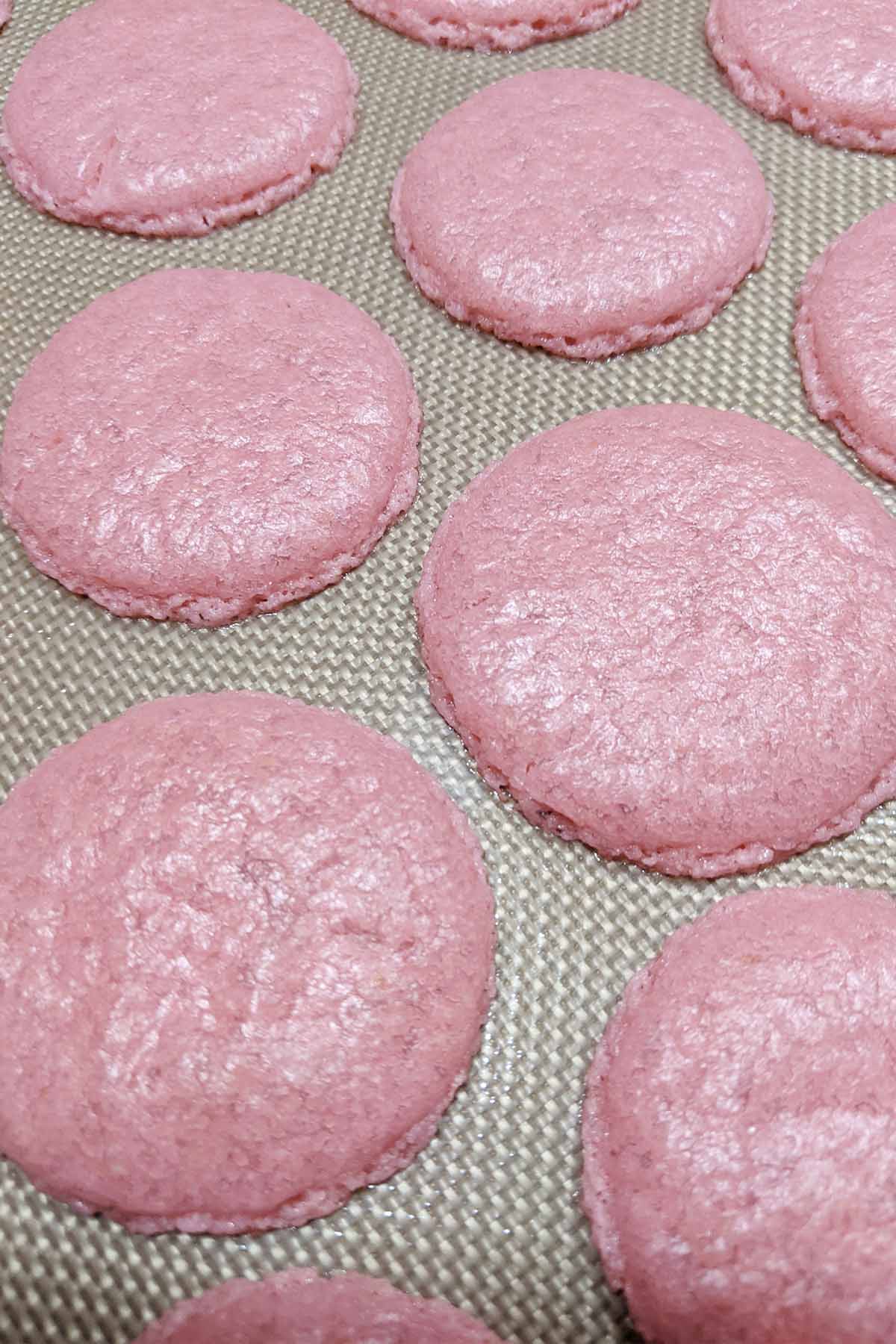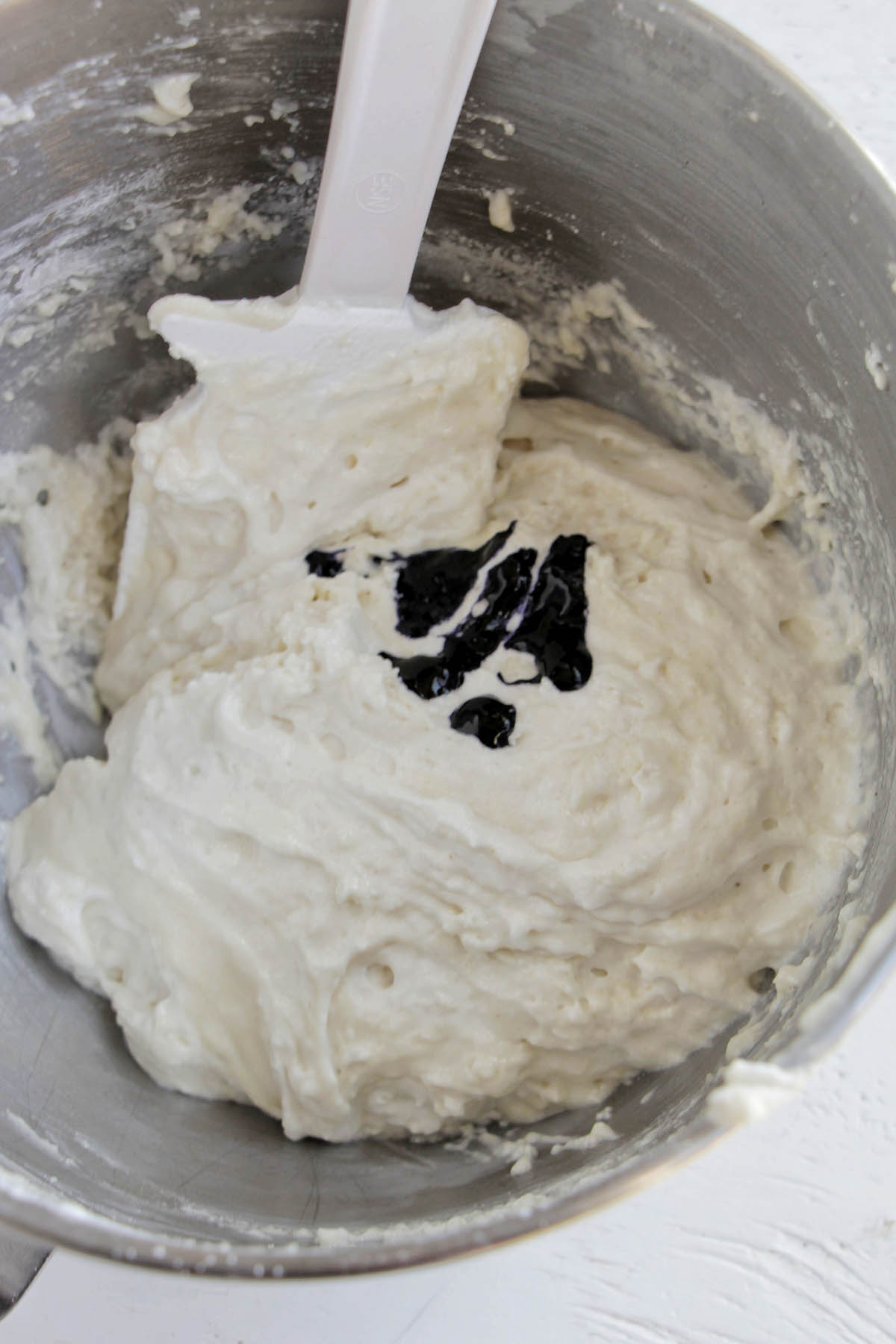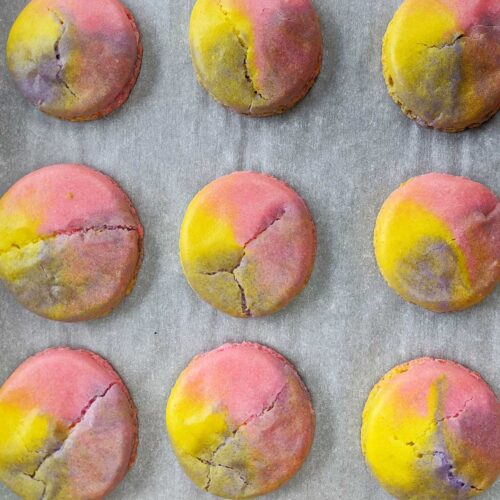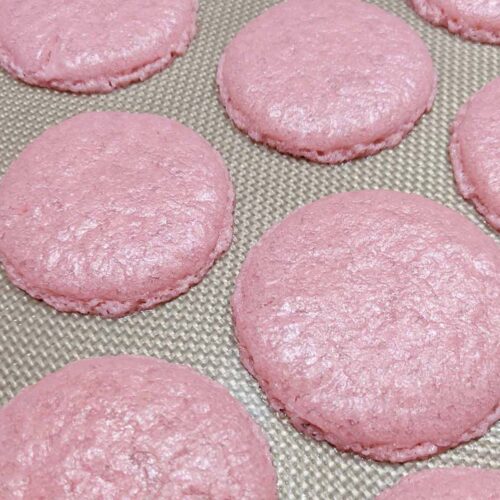Learn the proper techniques to make macarons with perfect feet. Plus, troubleshoot any issues you may be having with macaron feet including no feet, small feet, ruffled or spread out feet.

Want To Save This Article?
Enter your email below and we'll send it straight to your inbox. Plus, you'll receive new weekly recipe inspiration.
Baking macarons at home is a fun yet sometimes frustrating process.
Macarons are known for their delicate, almond-flavored shells and a delicious (usually sweet) inside filling. They're also known for being a fussy dessert that even the best pastry chefs mess up from time to time.
In this guide, I'll help you troubleshoot any problems you may be having related to macaron feet. Whether you have macaron feet that spread outwards, ruffled feet, or even small or non-existent feet, this guide will help you pinpoint your issue.
As always, remember that it takes some trial and error to bake macarons at home. Don't give up on your first or second attempt, keep going!
You can always refer to my macaron troubleshooting video or leave a comment below, and I'll do my best to help you out.
Jump to:
- What You'll Learn In This Article
- Troubleshoot Why Your Macaron Feet Are Ruined
- What Are Macaron Feet?
- Fix Macarons With No Feet or Small Feet
- Fix Macaron Feet Spreading
- Fix Macarons With Large or Ruffled Feet
- Tips To Achieve Perfect Macaron Feet
- 4 Reasons Your Macarons Are Failing
- FAQs
- More Macaron Troubleshooting Guides
What You'll Learn In This Article
- How to fix macaron feet that have spread out too much or look ruffled.
- Ways to fix macaron feet that haven't risen enough or are too small.
- Techniques you might be messing up that cause your macarons not to have feet.
If you are looking for some more specialized help with troubleshooting your macaron problems, sign up for my free macaron troubleshooting guide sent straight to your email.
What Are Macaron Feet?
Macaron feet are an iconic and very important part of the dessert to show that you have properly executed your technique, used the correct ratio of macaron ingredients, and have your oven set to the proper temperature.
During the baking process, a textured ring forms at the base of the shell. This is what is referred to as the macaron feet. The feet form as moisture in the macaron turns into steam and pushes the macaron upwards.
Technically speaking, the macaron feet should look like a round, evenly-sized circle at the bottom of the shell. You want to achieve a foot that's about two millimeters thick.
However, as you can see from the photo below, macaron feet can visually appear different. This photo was taken of macarons from various bakeries.
Even though there are slight visual differences in these macaron feet, they are all generally accepted and considered technically correct. We'll talk more below about how different ingredients, techniques, and equipment can affect the macaron feet.

Fix Macarons With No Feet or Small Feet
If you're having trouble with macarons that don't have any feet or have very small feet (under 2 millimeters), here are some problems you may have:

1. Oven temperature: Incorrect oven temperature is a common problem that may hinder your macarons from achieving perfect macaron feet.
An oven that's too cold will result in macarons that are wrinkled with little to no feet formation.
An oven that's too hot will also hinder the ability of feet to form because the macaron will bake too quickly. Normally, with an oven that's too hot, you'll also notice some browning on the macaron shells.
Most macaron bakers suggest baking macarons in a conventional oven between the temperatures of 290°F (143°C) - 325°F (163°C). These temperatures will need to be adjusted down 25°F if you're using a convection oven.
To fix this problem, purchase an oven thermometer and place it in the center rack of your oven. This way you can double-check the temperature reading before baking the macarons.
You can read more about my experiments with oven temperature if you're curious to learn more.

2. Over macaronaged: Macaronage is a term that refers to folding the dry macaron ingredients (almond flour and confectioners' sugar) into the meringue. This process smooths the mixture and helps the macarons bake with proper structure.
If you've over macaronaged your batter, it will be too thin and runny. This will cause your macarons to fall flat with small feet or even no feet.

To properly macaronage, continue to fold the batter until it reaches a lava-like consistency. You can test this by lifting your spatula and seeing if the batter drops almost like lava. Once it drops off the spatula, the batter that was dripped should fade back into the batter within 15-30 seconds (not too quickly).
Additionally, the almond flour should look blended into the meringue (not lumpy).
Many home bakers who are new to baking macarons will typically over macaronage. When in doubt, it's better to under macaronage by a little since the batter will continue to be worked in the piping bag.
3. Under whipped meringue: Properly whipping the egg whites to stiff peaks when making meringue is an important technique to get right.
The macarons need a strong base in order to rise in the oven. An under whipped meringue will not be strong enough to bake and develop the right-sized feet.
In order to achieve stiff peaks, you need to learn the visual cues you can use to know that your meringue has whipped to stiff peaks:
- You'll notice the meringue starts to ball up inside the whisk while it's mixing.
- The egg whites hold the indentation that the whisk makes as it's whipping.
- Pull the whisk out of the mixer. A stiff peak should stand straight up (no curl at the tip).
- You can see pointy off-shoots of egg whites on the whisk when you pull it out of the mixer.
- You can fully flip the bowl over and nothing moves or falls out.
- The meringue feels sturdy (not flimsy).
It typically takes around 8 - 10 minutes to reach stiff peaks, depending on your mixer and the speed. I use a KitchenAid mixer on speed 7.
There are different types of meringue including French, Italian, and Swiss meringue. I'd suggest trying a Swiss method or Italian method macaron if you're having trouble with sturdy meringue.
Also, remember that fats and oil interfere with the aeration of the egg whites. This could be causing your meringue to be under whipped. I like to wipe down my stand mixer bowl and whisk attachment with a little white vinegar on a paper towel to remove any leftover oils.

4. Not resting long enough: Many macaron bakers often have issues with their macarons related to not allowing the skin to dry for long enough before baking.
While there are many methods for no rest macarons or drying the macarons out in the oven at a very low temperature, most at-home macaron bakers prefer to allow their shells to rest at room temperature until a skin forms.
Typically, you'll need to allow the shells to rest for about 45 - 60+ minutes on the counter until a skin has formed on top. If you live in a humid climate, this may take up to 90+ minutes.
To test that the macarons are ready to bake, you can feel the shells and visually inspect the macarons. Here's what to look for:
- The shells appear matte in color (not shiny like when you first piped them).
- They are dry to the touch. You should be able to run your finger along the top of the shell without making an indent.
- When you gently and lightly push down on the macaron shell, you can feel some resistance and no mark is left.
If you live in a humid climate, it's very likely you're not resting the macaron shells long enough. Try running the air conditioning or a dehumidifier in your kitchen to take some of the moisture out of the air.
To help illustrate the importance of resting time, take a look at the photo below. You can see the macarons that rested only 40 minutes have smaller, less developed feet than the macarons that rested for 60 - 120 minutes.
If you're having trouble with this, check out my tips for how to fix macarons that aren't drying.

5. Batter is too wet: A batter that is too wet will cause flat macarons with little to no feet. A wet batter can be from macarons that have too many egg whites or egg whites that have too much water.
Egg whites are made up mostly of water. In fact, 90% of the egg white is water while only 10% is protein.
To resolve this issue, try aging your egg whites to reduce the amount of water in them.
To age egg whites you'll separate the egg whites from the yolks 2 - 5 days before baking the macarons. Place the egg whites in a container covered with plastic wrap.
Poke a couple of holes in the plastic wrap, and place the eggs back in the refrigerator. This allows some of the water to evaporate in the fridge.
Once you're ready to bake, allow the egg whites to come to room temperature before whipping them into meringue.
You could also be having an issue with overly wet batter if you used liquid food coloring. The food coloring that's recommended for macarons is gel coloring or powdered coloring.
These types of food coloring help you achieve the right color without adding in too much moisture.

6. Not enough granulated sugar: If you're developing your own macaron recipe, your ratio might be incorrect. If you consistently see no feet form on the macaron and it has somewhat of a wrinkly-looking top, you might need to add more granulated sugar to your recipe.
Chef Kathryn Gordon who wrote Les Petits Macarons suggests to slowly increase the granulated sugar in your formula by 1 - 2 tablespoons.
Fix Macaron Feet Spreading
If you're having trouble with macaron feet that have spread out or the macaron shell is sliding off the feet, here are a few things you may consider adjusting:

1. Oven temperature is too low, too high, or uneven: Oven temperature is tricky to get just right. As we discussed above, the oven temperature may vary depending on your home oven, its age, and how well/poorly it radiates heat.
If your oven is too low, you'll oftentimes see macaron feet that have expanded onto the parchment paper or silicone mat rather than rising up vertically.
On the opposite end, an oven that's too hot may cause slightly spread macaron feet as well as possibly some browning around the edges.
Older ovens that are not heating properly may cause macaron feet to spread due to uneven heat.
To remedy these issues, first purchase an oven thermometer and test the temperature of your oven by placing it in the middle rack of the oven.
You may want to also test various oven temperatures to find the perfect range for your home oven. I have an experiment I did with testing macaron oven temperatures that you can also replicate at home.
Finally, if you've perfected the oven temperature and are still noticing the macaron feet are spreading, try rotating the baking sheets in the oven during the baking process. You can move them from the top shelf to the lower shelf, as well as from one side of the oven to the other.

2. Under whipped meringue: Under whipped meringue can cause many issues including feet spreading, wrinkled macarons, and even cracked macarons.
Make sure that you're fully beating your meringue to stiff peaks. To test the meringue stiffness, pull the whisk out. A stiff peak should stand straight up (no curl at the tip).
Signs that you're ready to test the stiffness include seeing lines left from the beaters in your eggs. In addition, the meringue starts to almost ball up inside the whisk beater attachment.

3. Over macaronaged: Be sure to pay attention to how much you macaronage your batter. This is the term we use to describe the mixing of the dry ingredients with the meringue.
If your macaron batter is over macaronaged, it will be very runny and hard to pipe without spilling everywhere.
The batter should be a lava-like consistency. You can test this by lifting your spatula and seeing if the batter drops almost like lava. Once it drops off the spatula, the batter that was dripped should fade back into the batter within 15-30 seconds.
When in doubt, don't overmix the batter as you will continue to work it while you're piping the macarons.

4. Too much almond flour: If you're developing your own macaron recipe and are experiencing shells that slide off their feet or spreading too much, you may have too much almond flour in your recipe.
Be sure to re-adjust your macaron formula to reduce the amount of almond flour.
If you're using a well-tested recipe, like my French method macarons, be sure you are properly measuring the almond flour using a kitchen scale.

Fix Macarons With Large or Ruffled Feet
If you're experiencing macarons with ruffled, large, or frilly feet, you should look into the following possible problems:

1. Oven temperature too hot: Similar to flat shells or wrinkly macarons, a hot oven will cause the macarons to spread out too much.
Temperature can be a cause for ruffled feet, along with not using parchment paper or a silicone mat to help evenly distribute heat.
You can also try baking the macarons on two baking sheets (this helps distribute heat), or propping open the oven door with a wooden spoon to allow some of the oven heat to slowly vent.
2. Over macaronaged: As we talked about earlier in this article, macaronaging is a term that refers to folding the dry ingredients into the meringue and working the batter to a proper, pipable consistency.
An overworked batter can cause the macarons to spread out horizontally, rather than rising up vertically.
Be sure to work the batter slowly and carefully so you don't over macaronage. I personally like to spread the mixture along the side of the bowl, then wipe it back down. I repeat this process until the mixture is a smooth, lava-like consistency.
This method gives you a lot of control and doesn't quickly cause the batter to over macaronage.

3. Over whipped meringue: Over whipped meringue is when the meringue is whipped past stiff peaks. Typically, over whipped meringue begins to look dull and maybe even curdled if you've taken it really far.
If you've over whipped the meringue, you will have macarons that bake up with large feet (over 2 millimeters) or ruffled feet.
Stiff peaks should be achieved after about 8 - 10 minutes in the mixer running on medium-high speed (around speed 7 if you're using a KitchenAid).
If you're having trouble with over whipped meringue, set a timer to keep yourself aware of how long the process takes.
In addition to the visual cues we talked about above, here's a photo to help you see what stiff peaks look like.

Tips To Achieve Perfect Macaron Feet
In order to bake up macarons with perfect feet, be sure you have mastered the following:
- Use a well-tested recipe that has the correct ratio of each macaron ingredient and calls for gel or powdered food coloring.
- Always whip your meringue to stiff peaks. It's helpful to learn the visual cues of meringue that's at stiff peaks, so you can achieve consistent results.
- Properly macaronage your batter just until it reaches a lava-like consistency. This is another skill that takes practice and patience.
- Play around with your oven to find the perfect temperature. The perfect oven temperature is going to vary depending on whether you're using a conventional or convection oven. Oven temperatures can cause ruined macarons in many different ways, so play around with this factor until you've mastered your home oven.
FAQs
In order to achieve the perfect macaron feet, you need to properly whip the meringue to stiff peaks, use the correct ratio of macaron ingredients, perfectly macaronage the batter to a lava-like consistency, and have your oven set to the proper temperature.
There are a few different reasons why your macaron feet could be spreading in the oven:
- Your oven heat is too low, too high, or heating unevenly.
- You didn't properly whip your meringue to stiff peaks and it's under whipped.
- You over macaronaged your batter and now it's too runny.
There are a variety of reasons why your macarons have no feet. Here are some common issues:
- Your oven temperature is too cold or too hot.
- You under or over macaronaged the macaron batter.
- Your meringue is under whipped.
- The macarons didn't rest long enough to form a proper skin.
- The batter is too wet due to excess egg whites or liquid food coloring.
- Your recipe doesn't use enough granulated sugar.
There are a variety of reasons why your macarons have small feet. Here are some common issues:
- Your oven temperature is too cold or too hot.
- You over or under macaronaged the macaron batter.
- Your meringue is under whipped.
- The macarons didn't rest long enough to form a proper skin.
- The batter is too wet due to excess egg whites or liquid food coloring.
- Your recipe doesn't use enough granulated sugar.
There are a few different reasons you could be getting ruffled macaron feet:
- Your oven temperature is too hot.
- You over macaronaged the batter and it's too thin.
- Your meringue is over whipped.
A hot oven temperature could be causing your macarons to have tall feet.
Additionally, if you over whipped your meringue, it can cause tall feet to rise due to the excess amount of air in the batter.
More Macaron Troubleshooting Guides
Love this guide? Please leave a comment below. Don't forget to follow along on Instagram, Facebook, YouTube, and Pinterest for more recipes.












Beth
What a great resource - thank you! I just made my very first batch, and while they taste heavenly, the feet spread terribly. My oven is quite old, and I suspect that might be the issue. I used an oven thermometer, but I am wondering if the heat was uneven. I’ve never seen anyone recommend convection; have you tried this?
Jessica Mode
Hi Beth! I'm so glad this was helpful! My suspicion, since you said it was your first batch of macarons, is that you need to work on the macaronaging (mixing) step. This is something a lot of beginner macaron bakers have trouble with and it can cause ruffled/spread out feet. I'd also work with fine tuning your oven temperature as this will help too. Here's a helpful resource on that: https://homebodyeats.com/best-oven-temperature-for-macarons/
There are a lot of macaron bakers that use a countertop convection oven (most like the ninja foodi convection oven). There's also a learning curve to convection ovens and finding the right temperature. So personally, before I spent money on that, I'd play around with different temperatures in your current oven.
I have a macaron course that goes into lots more detail on all of the steps of macaron baking, if that's something that could be helpful to you: https://shop.homebodyeats.com/products/macaron-baking-experience 🙂